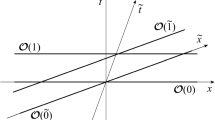Summary
Using the complex wave function satisfying the Schrödinger equation, we define gradient vector fields which will be used to rewrite the quantum-mechanical formulae such as the Schrödinger equation, the continuity equation and the canonical commutation relations. With these formulae rewritten by the gradient vector fields, we obtain correspondence among the quantum-mechanical formulae and the current and the stochastic velocities, the Fokker-Planck equations, the left and right derivatives which Nelson used for the stochastic quantization. We shall make some comments on the Schrödinger equation in case that a force proportional to the current or to the stochastic velocity is exerted. Next we treat the relativistic case in which, by making use of the complex wave function satisfying the Klein-Gordon equation, we define gradient vector fields. They play a central role in expressing several important formulae which have close analogy with some formulae appeared in the relativistic Brownian motion. Finally we study the Lagrangian density of a massive real scalar field minimally coupled to the gradient vector fields.
Riassunto
Per mezzo della funzione d'onda complessa che soddisfa l'equazione di Schrödinger si definiscono campi vettoriali di gradiente che saranno usati per riscrivere le formule quanto-meccaniche come l'equazione di Schrödinger, l'equazione di continuità e le relazioni di commutazione canoniche. Con queste formule, riscritte per mezzo dei campi vettoriali di gradiente, si ottengono corrispondenze tra le formule quanto-mecaniche e le velocità stocastiche e di corrente, le equazioni di Fokker-Planck, le derivate destre e sinistre che Nelson ha usato per la quantizzazione stocastica. Faremo qualche commento sull'equazione di Schrödinger nel caso che si eserciti una forza proporzionale alla corrente o alla velocità stocastica. Quindi si tratta il caso relativistico in cui, facendo uso della funzione d'onda complessa che soddisfa l'equazione di Klein-Gordon, si definiscono i campi vettoriali di gradiente. Questi giocano un ruolo centrale nell'espressione di parecchie formule importanti che hanno strette analogie con alcune formule comparse nel moto Browniano relativistico. Infine si studia la densità della lagrangiana di un campo scalare reale e con massa accoppiata minimamente ai campi vettoriali di gradiente.
Резюме
Используя комплексную волновую функцию, удовлетворяющую уравнению Шредингера, мы находим градиентные векторные поля, которые используются для изменения формул квантовой механики, таких как, уравнения Шредингера, уравнения непрерывности и канонических коммутационных соотношений. Используя эти формулы, измененные посредством градиентных векторных полей, мы получаем соответствие между формулами квантовой механики и стохастическими скоростями, уравнениями Фоккера-Планка, левой и правой производными, которые Нельсон использовал для стохастического квантования. Мы прокомментируем уравнение Шредингера в случае, когда действуют силы, пропорциональные потоку или стохастической скорости. Затем мы рассматриваем релятивистский случай, где используя комплексную волновую функцию, удовлетворяющую уравнению Клейна-Гордона, мы определяем градиентные векторые поля. Они играют существенную роль при выводе некоторых важных формул, которые аналогичны формулам для релятивистского броуновского движения. В заключение мы исследуем плотность Лагранжиана для массивного вещественного скалярного поля, минимально связанного с градиентными векторными полями.
Similar content being viewed by others
References
E. Nelson:Dynamical Theories of Brownian Motion (Princeton, N. J., 1967).
G. C. Ghirardi, C. Omero, A. Rimini andT. Weber:Riv. Nuovo Cimento,1, No. 3, 1 (1978).
M. D. Kostin:J. Statist. Phys.,12, 145 (1975).
K. Yasue:Ann. Phys. (N. Y.),114, 479 (1978).
K. Yasue:Hadronic J.,1, 1546 (1978).
V. L. Ginzburg andL. D. Landau:Ž. Ėxp. Theor. Fiz.,20, 1064 (1950).
J. P. Caubet:Probabilistic Methods in Differential Equations, edited byM. A. Pinsky (Berlin, 1975).
Author information
Authors and Affiliations
Additional information
To speed up publication, the author of this paper has agreed to not receive the proofs for correction.
Traduzione a cura della Redazione.
Переведено редакцией.
Rights and permissions
About this article
Cite this article
Nishioka, M. Role of certain gradient vector fields in quantum mechanics. Nuov Cim B 77, 19–30 (1983). https://doi.org/10.1007/BF02738415
Received:
Revised:
Published:
Issue Date:
DOI: https://doi.org/10.1007/BF02738415



